Panasonic Lumix DMC-FX35
-
-
Written by Gordon Laing
Panasonic Lumix DMC-FX35 design and controls
Panasonic’s FX35 is a slim, metal-bodied compact sporting the clean design and excellent build quality we’ve come to expect from the Lumix line-up. Beyond a few tweaks to the controls, it’s externally identical to its predecessor, the FX33, but that’s no bad thing. Measuring the same 95x52x22mm and weighing 146g with a card and battery, it’ll slip into most pockets without a problem. We’ve pictured it below, alongside Panasonic’s Lumix TZ5 superzoom, a chunkier compact, albeit one which packs-in an impressive 10x optical zoom – see our Lumix TZ5 review for more details.
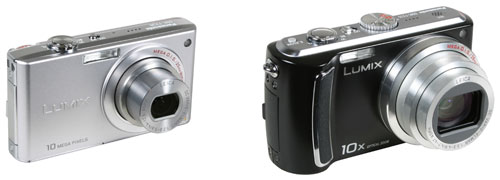 |
The FX35 shares the same clean front surface as its predecessor which at first glance doesn’t appear to have anywhere for your middle finger to grip. But like the FX33, the Lumix logo is cross-hatched which effectively prevents your finger from slipping. There’s also still the raised dots on the rear which act as a thumb rest, and the combination allows you to hold the camera relatively securely with one hand. Like its predecessor the build quality is superb, but if you’d like further protection along with the ability to dive down to a depth of 40m, the FX35 is compatible with the DMW-MCFX35 underwater housing.
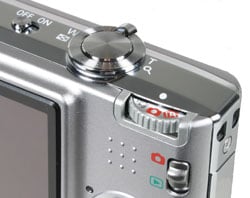 |
With both the FX35 and its predecessor side by side, you’ll spot a handful of changes to the controls. The power switch has been redesigned, the recessed mode dial simplified, and a new control added to the top right corner of the rear surface to switch the camera between Play and Record modes – Play mode was previously on the mode dial, and it makes more sense to have it on a separate control.
The new mode dial features five settings to its predecessor’s eight: Intelligent Auto, Normal Mode, Scene preset, Movie and Clipboard. Play has been moved to its own switch, Macro is now accessed from the rear controls and Print from the main menu system.
Round the back, the four-way controls with a Menu / Set button in the middle remain. During record mode, pushing up adjusts the exposure compensation or activates the backlight boost option, pushing right adjusts the flash, pushing down puts the FX35 into macro mode, while pushing left sets the self-timer between 10 and two seconds.
Below these are two buttons which cycle through the display options and fire-up the redesigned on-screen function menu, although the latter is now called Q.Menu. On previous Panasonics, this button doubled-up to adjust the LCD brightness mode, but that option has now sensibly been put onto the dropdown function menu instead – keep reading for full details.
Panasonic Lumix DMC-FX35 exposures and creative modes
The Panasonic Lumix DMC-FX35 has shutter speeds from 1/2000 to 8 seconds (or impressively up to 60 seconds in its Starry Sky Scene preset), along with two aperture settings at its disposal, although there’s no means to manually adjust them.
By carefully choosing one of the 22 Scene presets and adjusting exposure compensation though you can actually achieve a wide range of creative results, such as deliberately throwing the background out of focus on a portrait shot. If you’re into taking longer exposures in dim conditions though, be sure to change the minimum shutter speed from the default 1/8 to something slower – the menu allows you to adjust this between 1/250 and one second.
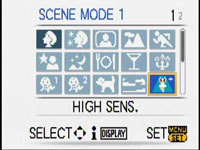 |
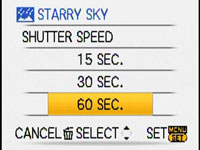 |
Panasonic’s Intelligent Auto mode, first seen on its July 2007 products including the FX33, now features further enhancements. As before it employs a number of cunning technologies which attempt to recognise what kind of photo you’re taking.
Automatic scene detection analyses the composition and if it recognises key elements it will select either the Portrait, Scenery, Macro, Night Scenery or Night Scenery with Portrait presets. If none fit the bill, the FX35 selects a general automatic mode. Next up comes Intelligent ISO which automatically detects motion in the frame and increases the sensitivity if necessary to allow a sufficiently quick shutter speed to freeze the action.
New to the FX35 and Panasonic’s 2008 range is Intelligent Exposure which can actually adjust the ISO over different portions of the frame. This first divides the frame into around 3000 areas, then finds the brightest portion and exposes for it using the lowest sensitivity. Then it increases the gain in the darker portions of the frame to boost detail in shadow areas.
While the idea of having different sensitivities on the same image sounds unusual, it’s not actually that different in practice to other dynamic range optimisation systems which digitally increase the brightness in darker areas. The result is also similar, where shadows are boosted, but at the cost of more visible noise in those areas.
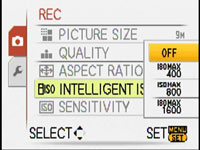 |
Intelligent ISO (with maximum limits if desired) and Intelligent Exposure can also be selected separately for the Normal shooting mode if desired, but are both active along with Automatic Scene Detection, Quick AF and the Image Stabiliser when the camera’s set to its Intelligent Auto mode.
It sounds ambitious, but proves surprisingly effective in practice. We repeated a test used on previous models and found the FX35 switched to Landscape mode when pointed at a distant mountain, adjusted itself to Macro when moved toward a close subject, then fired-up its Portrait preset with Face Detection when turned to people. The Intelligent ISO system also reacted well to subjects in motion. Sadly the latest addition, Intelligent Exposure, failed to make much impact on our test shots, but you may have more mileage.
While Intelligent Exposure didn’t impress in our tests, Panasonic’s Intelligent Auto mode overall remains by far the cleverest automatic system we’ve tested to date, exploiting a wide range of technologies, and we’d happily recommend it for day-to-day use and spontaneous shots. Then when you want to be more specific or creative, simply switch to Normal mode or one of the wider choice of scene presets.
|
Panasonic Lumix DMC-FX35 Flash
The Panasonic Lumix DMC-FX35 has a built-in flash with a variety of options cycled-through using right arrow button: Auto, Auto with red-eye reduction, Forced on, Slow sync with red-eye reduction and Forced off. There’s no flash compensation settings.
Panasonic Lumix DMC-FX35 Screen and menus
The Panasonic Lumix FX35 is equipped with 2.5in 230k pixel colour monitor which looks bright and crisp in operation. As with previous Panasonic compacts, the screen brightness can be adjusted using the LCD Mode options, but like its other 2008 models, this control has now been relocated from the Display button to the super-imposed Q.Menu.
There it offers the same options as before though: Power (brightening boost) and High Angle, along with an automatic mode which can detect bright surroundings and switch into Power mode. We found this worked well in our often bright outdoor conditions and would recommend leaving the camera in this mode unless you need to save power.
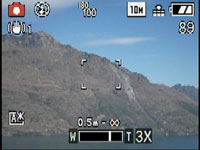 |
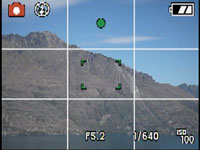 |
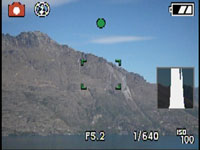 |
Pressing the Display button cycles between a clear view of the composition with no information, one with an alignment grid and one with detailed shooting information – and despite not letting you manually adjust the aperture or shutter, the FX35 is more than happy to tell you exactly what it’s going to use, along with the sensitivity. A menu option allows you to also display a live histogram over both the recording info and grid screens.
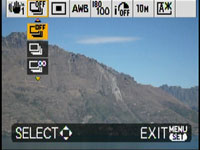 |
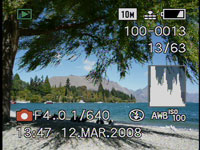 |
Like previous models, Panasonic splits (and often duplicates) its various settings over an overlaid function menu (now called Q.Menu) and a more conventional paged menu system. After using the same layout and graphics for some time though, Panasonic has opted for a redesign with its 2008 range, but the operation remains the same.
Pressing the Q.Menu button overlays a drop-down styled menu over your live composition and offers context-sensitive options. With the FX35 set to Normal recording mode, you can adjust the stabilisation mode, continuous shooting, AF area, white balance, sensitivity, Intelligent Exposure, image resolution and LCD brightness mode. Compression quality and image aspect ratio can now be found in the main menu system
Pressing the Menu button in Normal recording mode offers four pages of recording options and five setup pages; many of the common options are duplicated in the Q.Menu system.
With the FX35 switched into playback mode, the Display button cycles between a clean image and ones with varying degrees of detail – if you have Histograms enabled in the setup menu, one will appear in the third screen.
Panasonic Lumix DMC-FX35 Battery and connectivity
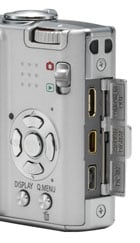 |
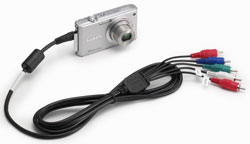 |
A single small door on the right side of the body opens to reveal a DC-input, a combined USB / AV port, and new to the FX35, a component output for the optional DMW-HDC2 cable. With this cable the FX35 will output a 1080i signal for HDTVs. A larger door under the grip side of the body houses the battery and SD memory card slot.
The Lumix FX35 is powered by the same DMW-BCE10E 1000mAh Lithium Ion battery pack as its predecessor and the camera is supplied with a mains recharger. Panasonic claims each charge is good for 290 shots under CIPA conditions, but like other Lumix compacts we found that estimate a bit optimistic. If you have the image stabiliser, continuous AF and auto LCD activated, you can burn through the battery pretty quickly, so investing in a spare would be advisable.




